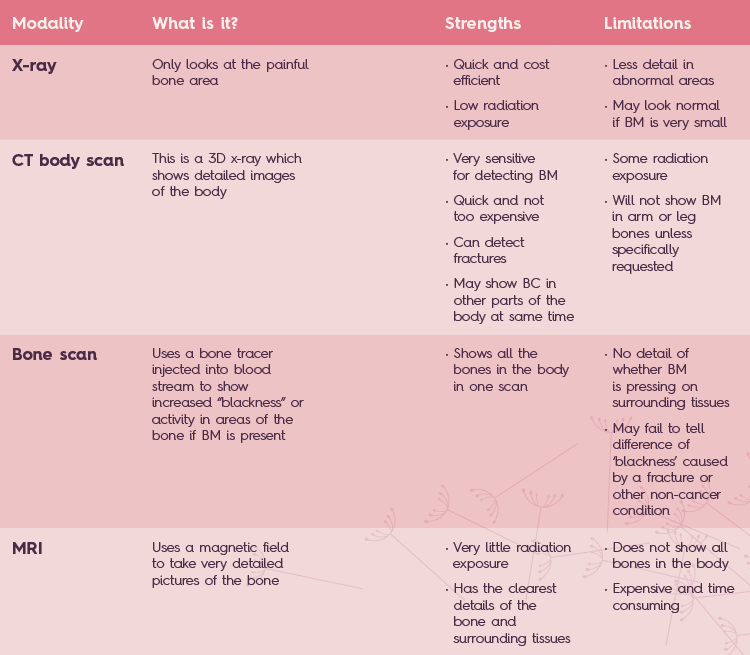Bone Metastases (BM)
In patients with metastatic or stage IV breast cancer (BC), the BC cells can frequently be found to have spread through the bloodstream to one or more bones in the body. These sites are called bone secondaries or metastases (BM). Your doctor might refer to them as ‘bone cancer’ or ‘bone lesions’. The spine (backbone) and pelvis are most commonly affected, but BC cells can go to any bone in the body. BC cells in the bone can “break down” areas in the bone (lytic) or make the bone more “dense or thick” (sclerotic).
Signs and Symptoms
Some patients with bone metastases may not get any symptoms at all, and they are found on scans being done for another reason. However, more commonly, patients feel pain in the bone region or may fracture in that bone with very little injury. The pain from BM is often moderate to severe in nature, constant over days to weeks, worse with movement of that bone, and may not get less with rest. Bone pain that is not related to BM usually gets better over time, is reduced by rest and does not interfere with your daily function.
Diagnosis
If your doctor suspects that you have BM, you will need specific tests.
Complications
Fracture through the bone where a BM is present.
A serious complication is spinal cord compression. Symptoms of this include sudden major increase in pain, which may “shoot” away from the area of the bone pain, cause weakness or numbness in arms or legs and in severe cases, inability to pass urine or incontinence of urine or bowel actions. If you experience any of these symptoms, urgent medical attention is advised (generally within 24 hours) so that assessment and treatment can be carried out to avoid permanent damage.
Another serious complication of BM is high levels of calcium in your blood. This may cause confusion, nausea, constipation, abdominal pain, increased thirst and generalised muscle weakness – these symptoms develop over days to a week or two.
Management
In broad terms, BM can be treated with drugs or localized treatment (radiation or surgery). The drugs used to manage a patient with stage IV breast cancer (i.e. chemotherapy or anti-hormone drugs) are equally effective in treating BM, as for metastases in other organs like the liver, lung, soft tissues etc.
-
Analgesics (Pain killers)
This includes paracetamol, anti-inflammatory medications and morphine-based drugs. If the BM is putting pressure on nearby nerves, anticonvulsant drugs like gabapentin can be useful.
-
Bone-targeted medications
This group of medications can be given by mouth, via injection into tummy fat or by infusion into the vein. The names of these drugs include alendronate, pamidronate, risedronate or zoledronic acid and denosumab.
These drugs dampen down bone cell damage by the BM and lead to increased bone strength and reduced bone pain. It also reduces the risk of fractures, spinal cord compression and lowers high calcium levels.
Before starting these drugs, you need to have a dental check because there is a small risk of developing osteonecrosis of the jaw (ONJ). Your dentist will know about this risk and know how to examine your teeth to make sure it is safe for you to start this drug. If you need any dental work beyond a scale & clean, you must tell your oncologist. Alongside these bone-targeted drugs, you also need to take a daily calcium and vitamin D supplement (any brand over-the-counter).
-
Radiation
If you have a lot of bone pain or one of the serious complications (like a fracture or spinal cord compression), your oncologist may refer you to a radiation oncologist. Radiation treatment can be directed to the BM and result in fairly quick control of the pain or complication in that bone.
-
Surgery
May be needed to prevent a bone with BM from fracturing (the risk of fracture is assessed by your oncologist). Surgery may also be needed release pressure on the spinal cord from a BM.
Apart from the specific treatment of BM, exercise has been shown to increase muscle strength and maintain higher physical activity without increased risk of pain or fracture. Ask your oncologist about a referral for an exercise program.
Full range of resources
Breast Cancer Research Center – WA aims to support and educate breast cancer patients. See our full range of resources and publications.
To read the Bone Metastases (BM) pamphlet in full, ask our staff at your next appointment or download it from our website.



